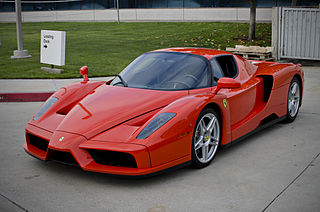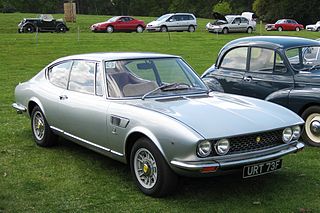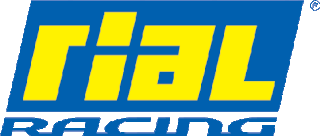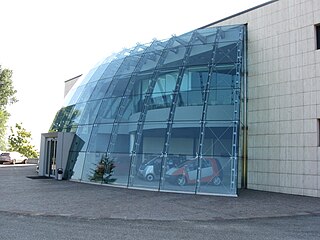Formula One, commonly known as Formula 1 or F1, is the highest class of international racing for open-wheel single-seater formula racing cars sanctioned by the Fédération Internationale de l'Automobile (FIA). The FIA Formula One World Championship has been one of the world's premier forms of racing since its inaugural running in 1950. The word formula in the name refers to the set of rules all participants' cars must follow. A Formula One season consists of a series of races, known as Grands Prix. Grands Prix take place in multiple countries and continents on either purpose-built circuits or closed public roads.
The Tyrrell Racing Organisation was an auto racing team and Formula One constructor founded by Ken Tyrrell (1924–2001) which started racing in 1958 and started building its own cars in 1970. The team experienced its greatest success in the early 1970s, when it won three Drivers' Championships and one Constructors' Championship with Jackie Stewart. The team never reached such heights again, although it continued to win races through the 1970s and into the early 1980s, taking the final win for the Ford Cosworth DFV engine at the 1983 Detroit Grand Prix. The team was bought by British American Tobacco in 1997 and completed its final season as Tyrrell in the 1998 Formula One season. Tyrrell's legacy continues in Formula One as the Mercedes-AMG F1 team, who is Tyrrell's descendant through various sales and rebrandings via BAR, Honda, and Brawn GP.

The Belgian Grand Prix is a motor racing event which forms part of the Formula One World Championship. The first national race of Belgium was held in 1925 at the Spa region's race course, an area of the country that had been associated with motor sport since the very early years of racing. To accommodate Grand Prix motor racing, the Circuit de Spa-Francorchamps race course was built in 1921 but until 1924 it was used only for motorcycle racing. After the 1923 success of the new 24 hours of Le Mans in France, the Spa 24 Hours, a similar 24-hour endurance race, was run at the Spa track.

The Italian Grand Prix is the fifth oldest national motor racing Grand Prix, having been held since 1921. Since 2013, it has been the Grand Prix held the most times, with 93 editions as of 2023. It is one of the two Grands Prix which has run as an event of the Formula One World Championship Grands Prix every season, continuously since the championship was introduced in 1950. Every Formula One Italian Grand Prix in the World Championship era has been held at Monza except in 1980, when it was held at Imola.

The Ferrari Testarossa is a 12-cylinder mid-engine sports car manufactured by Ferrari, which went into production in 1984 as the successor to the Ferrari Berlinetta Boxer. The Pininfarina-designed car was originally produced from 1984 until 1991, with two model revisions following the end of Testarossa production called the 512 TR and F512 M, which were produced from 1992 until 1996. Including revised variations, almost 10,000 cars in total were produced, making it at the time one of the most mass-produced Ferrari models.

Dino was a marque best known for mid-engined, rear-drive sports cars produced by Ferrari from 1957 to 1976. The marque came into existence in late 1956 with a front-engined Formula Two racer powered by a brand new Dino V6 engine. The name Dino was used for some models with engines smaller than 12 cylinders, it was an attempt by the company to offer a relatively low-cost sports car. The Ferrari name remained reserved for its premium V12 and flat-12 models until 1976, when "Dino" was retired in favour of full Ferrari branding.

The Ferrari Enzo, officially marketed as Enzo Ferrari, is a mid-engine sports car manufactured by Italian automobile manufacturer Ferrari and named after the company's founder, Enzo Ferrari. It was developed in 2002 using Formula One technology, such as a carbon-fibre body, F1-style automated-shift manual transmission, and carbon fibre-reinforced silicon carbide (C/SiC) ceramic composite disc brakes, as well as technologies not allowed in F1, such as active aerodynamics. The Enzo generates substantial amounts of downforce through its front underbody flaps, small adjustable rear spoiler and rear diffuser, which work in conjunction to produce 3,363 newtons (756 lbf) of downforce at 200 km/h (124 mph) and 7,602 newtons (1,709 lbf) of downforce at 300 km/h (186 mph), before decreasing to 5,738 newtons (1,290 lbf) at top speed.

Formula One automobile racing has its roots in the European Grand Prix championships of the 1920s and 1930s, though the foundation of the modern Formula One began in 1946 with the Fédération Internationale de l'Automobile's (FIA) standardisation of rules, which was followed by a World Championship of Drivers in 1950.

The Fiat Dino was a front-engine, rear-wheel-drive sports car produced by Fiat from 1966 to 1973. The Dino name refers to the Ferrari Dino V6 engine, produced by Fiat and installed in the cars to achieve the production numbers sufficient for Ferrari to homologate the engine for Formula 2 racing.

The 1970 Formula One season was the 24th season of the Fédération Internationale de l'Automobile's Formula One motor racing. It featured the 21st World Championship of Drivers, the 13th International Cup for F1 Manufacturers and three non-championship races open to Formula One cars. The World Championship was contested over thirteen races between 7 March and 25 October.

Rial is a German producer of light alloy wheels and rims, and was a Formula One constructor competing in the 1988 and 1989 seasons. Founded in the 1970s as a wheel rim producer, the company was bought by Günter Schmid, ex-owner of the ATS wheels company in 1987. Schmid followed the same strategy as he had at ATS, advertising the Rial wheel brand by entering Formula One as a constructor. Rial participated in 32 Grands Prix, entering a total of 48 cars. They scored six championship points, finishing a highest of ninth in the constructors championship in 1988. After leaving Formula One at the end of the 1989 season, the Rial Racing division was closed, and the company did not race again. Rial continues to manufacture wheels and rims from its factory in Fußgönheim.

Pininfarina S.p.A. is an Italian car design firm and coachbuilder, with headquarters in Cambiano, Turin, Italy. The company was founded by Battista "Pinin" Farina in 1930. On 14 December 2015, the Indian multinational giant Mahindra Group acquired 76.06% of Pininfarina S.p.A. for about €168 million.

The Williams FW07 was a ground effect Formula One racing car designed by Patrick Head, Frank Dernie, and Neil Oatley for the 1979 F1 season.
Experimental safety vehicle (ESV) is the designation for experimental concept cars which are used to test car safety ideas.

The Ferrari F2007 is a Formula One motor racing car that was constructed by Scuderia Ferrari Marlboro to compete in the 2007 FIA Formula One World Championship. The F2007 was the fifty-third single-seater car which the team have built to use in Formula One.

Paolo Martin is an Italian car designer widely known for his career with Studio Tecnico Michelotti, Carrozzeria Bertone, Pininfarina and De Tomaso/Ghia where he styled the Ferrari Dino Berlinetta Competizione, Ferrari Modulo concept, Fiat 130 Coupé and the Rolls-Royce Camargue.
The regulations governing Formula One racing have changed many times throughout the history of the sport.

The Ferrari 458 Italia is an Italian mid-engine sports car produced by Ferrari. The 458 is the successor of the F430, and was first officially unveiled at the 2009 Frankfurt Motor Show. It was succeeded by the 488 GTB in 2015.
Giorgio Stirano is an Italian racing car engineer, who worked for Forti and Osella in Formula One.

The Ferrari 166 F2 is an open-wheel formula racing single-seater car, designed, developed and built by Italian manufacturer and team Scuderia Ferrari, for Formula 2 racing, in 1948. This is the car in which Argentinian driver, and eventual five-time Formula One world champion, Juan Manuel Fangio, became known in Europe.















